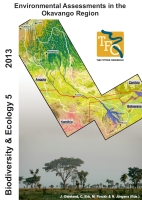
|

Department of Biology Institute of Plant Science and Microbiology |
| Division BEE > Biodiversity & Ecology > Vol.5 > Article 54 |
Biodiversity & Ecology
Journal of the Division Biodiversity, Evolution and Ecology of Plants , Institute for Plant Science and Microbiology, University of Hamburg.
Research Article Open Access Spatial variation of population size structure of selected riparian tree species in the Okavango Delta, Botswana Keywords: Diameter at breast hight (dbh); Okavango; Recruitment; size class distribution (SCD); Species
Título: Variação espacial da estrutura de tamanho da população de espécies selecionadas de árvores ribeirinhas no delta do Okavango, Botsuana Palavras-chave: diâmetro à altura do peito (DBH); distribuição por classe de tamanho (SCD); espécie; Okavango; recrutamento Resumo: A transpiração de árvores ribeirinhas no delta do Okavango, Botsuana, cria um gradiente de salinidade que facilita o movimento contÃnuo de água dos pântanos para as ilhas. Isto leva a acumulações de sal debaixo das ilhas que minimizam a salinidade da água de superfÃcie. O objetivo deste estudo foi investigar a variação espacial na estrutura de tamanho da população de espécies de árvores ribeirinhas no delta. Postula-se que a estrutura da população de árvores ribeirinhas irá variar espacialmente devido à diferentes condições hidrológicas. A vegetação ribeirinha foi monitorada em Boro, Santawani, Moremi, Vumbura e Seronga de um total de 75 terrenos de 20m x 50m. As espécies escolhidas para esse estudo, em termos de sua posição dominante foram Croton megalobotrys Müll. Arg, Philenoptera violacea (Klotzsch) Schrire, Diospyros mespiliformis Hochst. Ex A.DC e Acacia nigrescens Oliv. O diâmetro à altura do peito (DBH) foi medido em arbóreas com diâmetro do caule maior que 2.5 cm. A análise de regressão linear foi utilizada para inferir a distribuição de classe por tamanho da população de cada espécie. A Croton megalobotrys Müll. Arg mostrou um padrão de distribuição de classe reverso de tamanho J (SCD) em Boro, Santawani e Vumbura enquanto mostrou um padrão em forma de sino em Moremi. A Philenoptera violacea (Klotzsch) Schrire mostrou um padrão irregular de distribuição de classe de tamanho, com algumas classes de tamanho faltando em Boro e Santawani, enquanto mostrou uma forma padrão de distribuição revertida de classe de tamanho J, com mais indivÃduos nas classes de tamanho inferiores em Vumbura. A Diospyros mespiliformis Hochst. Ex A.DC mostrou um padrão SCD em forma de U em Boro e padrão irregular em Seronga e Vumbura. A Acacia nigrescens Oliv. mostrou um padrão SCD irregular com algumas classes de tamanho faltando em Boro e Santawani e reverse J shaped SCD pattern com mais indivÃduos nas classes de tamanho inferiores em Seronga.
Suggested citation: |
